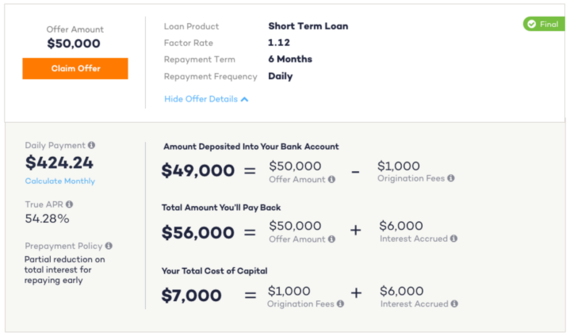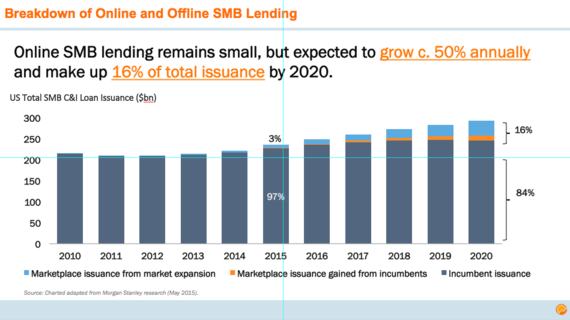We're proud of the progress that we've made at Fundera to bring transparency to small business lending, and the work we've done to become a small business borrower's most trusted marketplace when looking for a loan. We don't just pay lip service to that mission; we live it, it informs everything we do, and our commitment to it has been longstanding. We highlight some of our major successes on bringing transparency to small business lending in this interactive timeline, including our leadership as a founding member of the coalition to create the Small Business Borrowers' Bill of Rights.
Fundera is making further progress on its mission to bring transparency to small business lending with the release of a standardized disclosure box on our site, which we hope can serve as a minimum viable product for the lending industry to consider. Our box aims to lay out core metrics that a small business borrower deserves to know about their credit options before signing on the dotted line. The challenge is two-fold: balancing substance--that is to say, everything a borrower needs to know to make an informed decision--with simplicity, or relaying such information in a way that a borrower can easily understand.
We first highlighted this disclosure box in a fireside chat we held at Fundera's office featuring Karen Mills, a former SBA administrator and current fellow at Harvard Business School, as well as my co-author on a 2014 working paper on the state of small business lending. The box won praise from Karen, and will inform part of the recommendations in a new report that we'll release together later this year on a regulatory framework for online small business lending.
Example Term Loan Disclosure Box
Here's what our term loan disclosure box looks like.
This is a box that will be shown when borrowers see short-term loan offers (with a duration of 3-18 months) as well as medium-term loan offers (1-5 years) on Fundera's site. We absolutely believe that these products present viable options that small business borrowers deserve to know about when searching for credit. And, while short-term loans bear high APRs, they may be the only option for borrowers with lower credit scores and revenues. (Incidentally, due to Fundera's marketplace approach, which pushes lenders to compete for a borrower's business, borrowers report effective APRs that are 15% below available industry averages.)
We feel passionately that borrowers deserve to know basic stats on these products. We envision the box will be to small business loans what nutrition labels are to food. Instead of listing calorie and carbohydrate counts, the box lists key stats on a borrower's loan such as the APR, monthly and daily repayment, fees including origination fees and financing charges, and whether or not there are any prepayment savings, or in effect penalties, associated with credit products.
In addition to our term loan disclosure box, we've created a merchant cash advance (MCA) box which can be seen in a post from Peter Renton of LendAcademy here, and are working on disclosure boxes for invoice financing as well as business credit and charge cards.
Online Lenders Need to Get Serious About Disclosures
The problem is that credit extended for a business or commercial purpose is not covered by the disclosure requirements of the federal Truth in Lending Act, which leads lenders to display loan terms and costs inconsistently. Some bury prepayment penalties deep inside 3-inch-thick loan documents. Few disclose an annual percentage rate, a number that would help loan prospects comparison shop.
A recent focus group study conducted by the Federal Reserve Bank of Cleveland was telling. The research found that mom-and-pop business owners are hard-pressed to compare credit products when using information provided on online alternative lenders' websites. That kind of opacity poses a real problem for borrowers. After all, how can they get a fair shot at making informed financing decisions absent full and fair information about their loan options?
Lack of a model disclosure is even more concerning amid rapid growth of nonbank online lenders. As the chart below underscores, by 2020 Morgan Stanley estimates that nonbank lenders will account for 16% of total small-business lending. These lenders are subject to less oversight on borrower protection than brick-and-mortar banks. In part because of this regulatory arbitrage, they are less likely to disclose basic terms and costs of loans in borrower-friendly ways.
We think six bedrock principles which we first highlighted in an August 2016 op-ed in American Banker should guide the discussion on the disclosure boxes. We endeavored to build our disclosure box on these principles, though it's not perfect and we welcome feedback from lenders, consumer protection advocates and borrowers themselves over the coming months on how to make it better.
These Core Principles Should Inform a Disclosure Box for the Digital Age:
Conspicuous. The disclosure box should be conspicuously presented in boldface type at the top of loan documentation so that borrowers don't have to waste time searching for the information. Small-business owners are generally time-strapped, particularly when they are searching for a loan. The average small-business owner spends 24 to 72 hours talking to lenders, filling out loan applications and submitting documentation, according to a survey conducted by seven Federal Reserve banks. Small-business owners deserve to see their terms without having to flip through pages of complicated documentation.
Comprehensive. The box should capture all relevant information that borrowers should care about when making a loan decision. Indeed, in the Federal Reserve's same focus group highlighted above, virtually all participants said they want to see stated product features like duration, origination fees, financing charges expressed in dollar amounts and interest rates, as well as clear and conspicuous descriptions of late fees and prepayment penalties. Disclosure of monthly loan repayment terms would also be helpful given that small-business owners are more likely to think of their business cash flow on a monthly, rather than a daily, basis.
Comparable. The disclosure box should empower borrowers to make straight-up and, where possible, side-by-side comparisons among loan options. While imperfect, universal disclosure of metrics such as an APR would help would-be borrowers understand their options. Sure, absent education about what an APR represents, the metric can be confusing to borrowers -- especially for loans with durations of less than one year; however, an APR is ultimately something borrowers are familiar with when seeing the price of other financing products, like credit cards. It's also the only widely used metric for incorporating all origination fees and financing charges; therefore, it helps borrowers compare the true and total cost of credit products. To strike the right balance, model disclosures should show APRs, while also including straightforward language that highlights the pros and cons of this metric for particular products and terms.
Clear. The disclosure box should be written in plain English. Modern behavioral economics shows that there are distinct limits to people's ability to internalize complex financial products. In other words, lenders have an elevated responsibility to make sure language is truly understandable to borrowers. The purpose of a disclosure is -- of course -- to ensure that borrowers get a fair shot to understand the risks and rewards of any credit product before making their decisions.
Contemporary/Interactive. The disclosure box should also go beyond the static table snapshot of the "Schumer Box" with fully interactive tools that empower small business owners to make informed financing decisions, and lays out the metrics they deserve to understand in a user-friendly way.
Correct. The disclosure box shouldn't oversimplify or overcomplicate a loan's terms to the point of inaccuracy. Crafting a universal disclosure is difficult, particularly when considering the complicated nature of small-business loan products. Each loan comes with varying terms, repayment methods and use of proceeds. The challenge is to implement a disclosure box that balances the above considerations, many of which can be competing, while educating borrowers on the nitty-gritty of their credit offers.
Justice Louis Brandeis famously observed that "sunshine is the best disinfectant." A century later, his words still ring true: we need more sunshine in small business lending. Full transparency will not happen overnight; however, Fundera has an obligation to our borrowers to make sure it happens on our site, and we hope it informs industry conversations on what a model disclosure box could look like.
Brayden McCarthy is VP of Strategy at Fundera, and was formerly a presidential appointee serving in the Obama administration as senior policy advisor at the White House National Economic Council and U.S. Small Business Administration.

